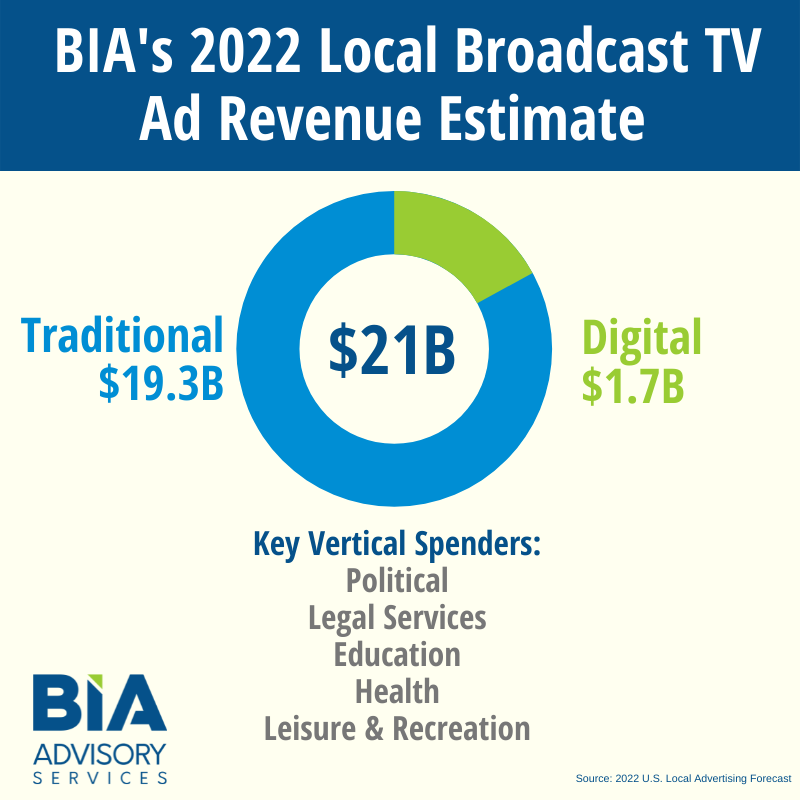BIA Sees 26.5% Bounce in 2022 Local Broadcast Ad Revenue
Local TV ad revenue will hit $21B in 2022, with $19.3B from OTA and $1.7B from digital

CHANTILLY, Va.—BIA Advisory Services is predicting that the midterm election year will be a good one for local broadcasters, with political advertising boosting the local broadcast ad revenue to $21 billion in 2022.
BIA is forecasting that $19.3 billion come from over-the-air (OTA) revenue and $1.7 billion in digital, a big jump of 26.5% for the industry.
The new forecast will be released in an address by Tom Buono, founder and chief executive officer of BIA Advisory Services at the TVB Forward Conference on September 30.
In the address Buono will argue that key drivers include a long and significant political advertising season, growth in TV’s digital advertising opportunities, and positive economic signs for key verticals.
“There are many factors that go into our forecasting,” said Buono. “We take into consideration economic trends, consumer behavior, growth in digital ad spending and the local advertising environment. These points have all shifted in an unorthodox way since the pandemic first hit and are now affecting television viewing habits and local advertising spending.”
Buono said that BIA’s analysts saw a V-shaped recovery in local advertising from 2019 to 2021 – with a $10 billion dip in 2020 and a close return in 2021 to pre-pandemic levels.
Over the long-term, the BIA is expecting that local advertising in the U.S. to continue in a positive direction barring any new disruptions. BIA is now estimating a 3.4 percent compound annual growth range over this projected period.
The professional video industry's #1 source for news, trends and product and tech information. Sign up below.
The most significant factor going into 2022 for local broadcast TV, Buono explained, is that political advertising spending will be extremely strong for a significant portion of the year.
BIA expects political advertising next year to rival 2020 and even experience further expansion by 2024.
The BIA’s combined forecasted local TV spend for political is $3.4 billion in 2022, with 44.8% of local media political advertising going to OTA broadcast TV alone. The top five markets for next year’s political advertising will be New York City, Los Angeles, Atlanta, Phoenix, and Philadelphia.
Growth in OTT is also significant. With many Americans’ continuing to work from home and shift their viewing habits, over-the-top (OTT) has become more of a focus for many broadcasters.
According to BIA’s estimate, OTT ad spending is expected to reach $1.17 billion in 2021, $1.64 billion in 2022, and will surpass $2 billion by 2024.
“While the total local advertising trend in the U.S. is positive, it’s imperative to note that most of the growth is happening on the digital side, which includes mobile, online, and OTT ad channels. We expect local digital to exceed local traditional in 2023 (due in large part to continuing declines in print media advertising), making cross-platform selling even more important in the future,” said Buono.
Advertising in 2020 during the pandemic took its toll on many of the key verticals, BIA said. Leisure and recreation, auto and retail were hit especially hard.
But many verticals have improved in 2021 from a lower base in 2020 and will continue to show improvement for next year.
For TV OTA, key verticals increasing their spending ad dollars in 2022 will be education, legal services, health, leisure and recreation, and political, BIA predicts.
Possible target categories for the broadcast TV industry include supermarkets, wireless carriers, quick service restaurants (QSRs) and hospitals.
In early September, BIA released its 2022 U.S. Local Advertising Forecast for 16 media, including local broadcast television, and 96 business sub-verticals. The five-year forecast is available for all 210 local television markets and is based on a proprietary forecasting methodology of the local advertising marketplace. Forecast data is delivered by the local advertising intelligence dashboard, BIA ADVantage.
More information is available here.

George Winslow is the senior content producer for TV Tech. He has written about the television, media and technology industries for nearly 30 years for such publications as Broadcasting & Cable, Multichannel News and TV Tech. Over the years, he has edited a number of magazines, including Multichannel News International and World Screen, and moderated panels at such major industry events as NAB and MIP TV. He has published two books and dozens of encyclopedia articles on such subjects as the media, New York City history and economics.

